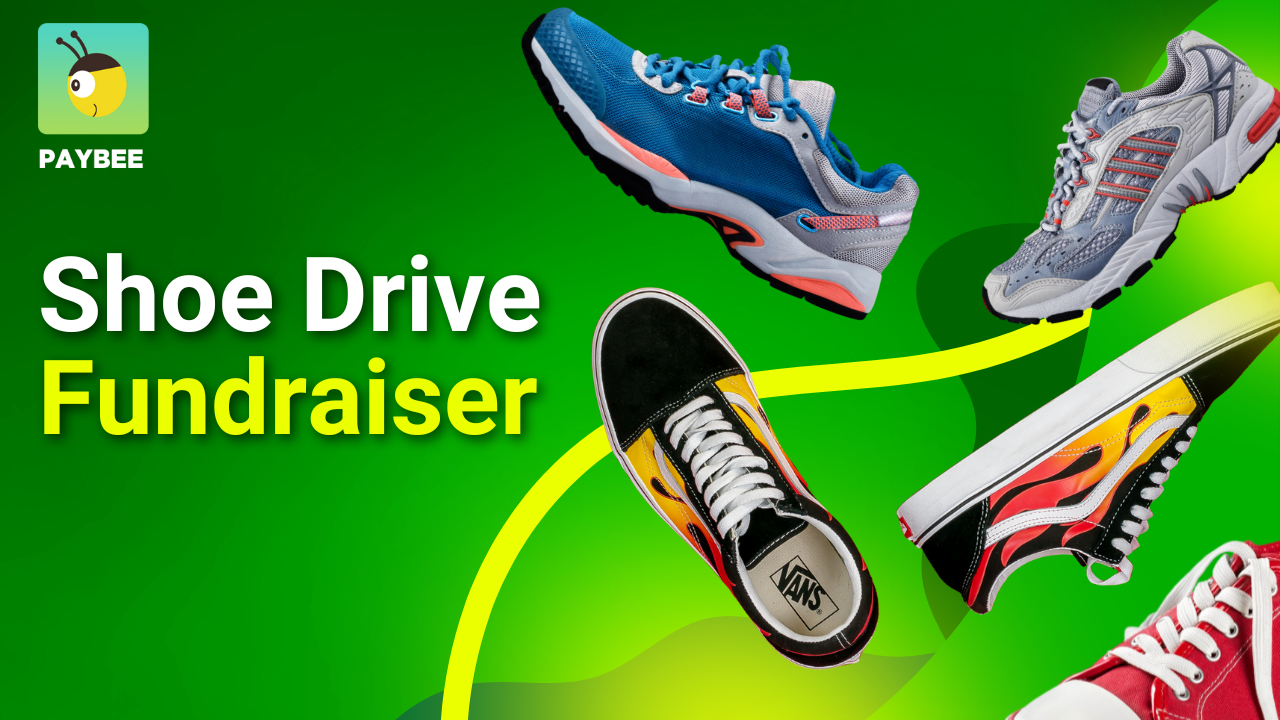
Shoe Drive Fundraiser: Turning Old Sneakers Into New Opportunities
Shoe Drive Fundraiser: Turning Old Sneakers Into New Opportunities
Quick Answer: How to run a shoe drive fundraiser?
Instead of a traditional fundraiser where you ask donors for money, instead ask donors for used shoes. Collected shoes are then typically repurposed and given to those in need. TO run a shoe drive successfully, consider finding a partner organization to help you repurpose the shoes and get them to those who need them.
Did you know that every year Americans throw away over 300 million pairs of shoes with most of them ending up in landfills where they take decades to decompose while creating a massive mountain of waste? But it doesn’t need to be that way. The good news is your old sneakers, flats or boots can do more than collect dust, they can be transformed into cash for your school, team or nonprofit, while also keeping usable footwear in circulation for communities around the globe.
So the real appeal of a shoe drive fundraiser is their low effort and high impact positive effects. They’re super simple to plan and pull off and they not only help local people in your neighborhood, or even bring in some extra cash for your cause, they’re also extremely environmentally helpful and pretty much every step is completely free. You don’t need weeks of complicated planning. You collect shoes. That’s it. Even if you’re a minor just starting your own nonprofit, this is something you can pull off.
Why Choose a Shoe Drive Fundraiser?
Here’s the short version:
- Zero upfront costs. You don’t need to buy inventory or rent space.
- Global reach. Collected shoes often support micro-entrepreneurs in developing countries.
- Eco-friendly. Keeps textiles out of landfills and supports reuse.
- Community-driven. Engages donors who may not give cash but are happy to clear out closets.
- Easy to promote. Works perfectly with seasonal rhythms like spring cleaning or back-to-school drives.
Think about the beauty of this, instead of asking people to spend money, you’re simply asking them to declutter their closets and give you what would end up in the trash anyway. That’s a much easier “yes” and the response can even be overwhelming!
What Exactly Is a Shoe Drive Fundraiser?
There are actually two ways of going about a shoe drive fundraiser. The first is when schools, churches, sports teams or nonprofits collect gently used shoes and redistribute them to the people that need them within your community. There is normally no money involved and you’re simply taking shoes from one individual, and giving them to another.
Shoe Drive Fundraiser Basics
The second common reason to hold a shoe drive is to bring in funds for a cause. So again, footwear is collected but in this scenario they are sold to organizations that pay you by the pound. The shoes are then resold by the companies or repurposed in developing markets thus creating small business opportunities abroad. Your group earns money for every bag of shoes collected while also supporting small ventures abroad.
Both scenarios are great wins for everyone involved, and especially so for the environment. After all, 300 million shoes is a lot! And how many other fundraisers or events do you know of where all the profits come from something free, and for most, literally from garbage!
5 Reasons Shoe Drives Outperform Traditional Fundraising Events
- No financial risk. Unlike selling products, you won’t get stuck with unsold stock.
- Bigger participation. Everyone has a pair of old shoes, but not everyone has the cash to give.
- Eco impact. Reduces textile waste while raising funds.
- Storytelling power. “Your old sneakers helped a child get textbooks” is a message that resonates.
- Longer shelf life. Shoe drives can run for weeks so people have plenty of time to contribute.
Why Shoe Drives Matter: Triple Impact
Shoe drive fundraisers definitely look simple on the surface, just collect and donate sneakers, but the ripple effect they create is profound. These initiatives generate benefits on three levels: environmental, social, and local. And all from an otherwise waste product that would otherwise most likely land in your local garbage dump.
A. Environmental Benefits
Every year in the USA millions of pairs of shoes end up in landfills where their rubber soles and synthetic materials can take decades to break down while also adding chemicals to the ground and possibly even the water table. But by donating sneakers through a shoe drive, your community can drastically reduce landfill waste and give old footwear a second life or be upcycled into new products, making this one of the most Eco-friendly fundraisers available. Shoe recycling isn’t just about decluttering closets, it’s also about protecting the planet.
B. Social & Global Impact
If your cause isn’t focusing on the local needs of the community, the footwear you collect will most like wind up someone abroad. Many collected shoes end up being distributed to developing nations where access to affordable and durable footwear is limited. Better still, many will end up going to microprenuers which are usually families that will either pay for the sneakers by the pound as well, or a small fee per pair, and then sell them on at their local markets while creating sustainable income streams for their families. This means your old sneakers don’t just sit in a closet or in a landfill, they help fuel jobs, dignity and opportunities worldwide. Truly, it’s a global shoe donation impact that goes far beyond your neighborhood.
C. Fundraising for Local Causes
Whether you’re collecting to give some of your donations to local shelters or families that need a hand, or you’re collecting funds for schools, nonprofits and community programs, organizations can raise hundreds or even thousands of dollars without selling raffle tickets or candy bars, but just by encouraging supporters to clean out their closets. A single shoe drive fundraiser can support youth sports teams, after school programs or vital community services. This unique model turns something most people already have, unused shoes, into a steady stream of funding for causes that matter.
Seasonal Timing That Works
The best shoe drives tap into natural rhythms of the year. Think:
- Spring cleaning. People are already decluttering closets and garages.
- Back-to-school. Parents are swapping out shoes their kids outgrew over the summer.
- End-of-year. Families making space before the holidays are happy to donate.
If you can time your campaign to these timelines, it’ll be a lot easier to reach your golas, and a lot faster.
How to Start a Shoe Drive Fundraiser (Step-by-Step)
Running a shoe drive sounds simple, and it is, but that doesn’t mean you don’t need a clear plan of action in order to make sure you’ve got all your bases covered. Our step by step plan below goes over each and every step, and if oyu just follow whet we’ve written, you’re guaranteed to do better than if you hadn’t. So just go through and check each step off, and you’ll be helping the world in no time.
1. Pick Your Timing and Set Goals
Start by choosing the right time or season to kick off your drive. Spring cleaning and back to school are natural fits, but end of year decluttering works too. Decide how long you’ll run your drive, anywhere between four to six weeks is typical. Next set a goal that’s concrete so you can see how well your event did when it’s finished. If you’ve never done an event like this, start with a small number like 500 pairs of sneakers to start or “1,000 raised. This will not only keep you focused, but it will help others to become motivated as well.
2. Partner With a Nonprofit or Shoe Fundraising Company
If you alan to keep your collections local, you’ll need to know how to get them into the hands of those that need them most. Partnering with a local food bank or homeless shelter is a great start and they can often assist you with handing out your footwear. There are many types of nonprofits, like human trafficking or after school programs that may not advertise the need for shoes, but can definitely help you find people in need of your gifts.
There are also dedicated shoe fundraising companies such as Funds2Orgs or Soles4Souls that work with other companies and NGO’s around the world and they can easily pick up and ship your shoes. They’ll even figure out shipping or payouts and help you with other logistics. Just be sure to partner with a company that specializes in shoe drives and they’ll send bags or boxes, handle pickups and pay your group by the pound or by pair collected.
3. Plan Logistics
Since shoes are a physical item, that means you’ll need to get them, store them and disperse them. This is all logistics. This means choosing a central location for drop offs such as a school, community center or local business while making sure it’s accessible and no one is going to steal your donations. You’re also going to need to arrange collection bins and schedule pickups for the donated shoes, or even look into having a service that goes to people’s homes to grab them. This can all be done yourself, but it can really help to have a few volunteers or another organization helping out.
4. Promote Your Drive
Now that all the planning stuff is out of the way, it’s time to let people know about your event. Since your drive will be mostly local focused, think of every single way you can to let people know you want their old shoes. Use every communication channel you have at your disposal to maximize visibility:
- Social media posts and event pages
- Flyers in local businesses
- Announcements in newsletters or community bulletins
- Word of mouth through volunteers and supporters
- Local radio, newspapers or even TV
5. Track Progress and Celebrate Milestones
You should be sharing milestones through out your event to keep people interested and build momentum. Post weekly updates like “We’ve collected 200 pairs, almost halfway to our goal!” People like seeing their efforts pay off, and by keeping everyone up to date, they also feel like part of the journey. Once you actually reach your target, celebrate. A photo of smiling volunteers standing beside bags of shoes says more than any thank you card.
6. Wrap Up and Celebrate
Once you’ve reached your goal, either connect with your partner organization for pickup and confirm the total shoes collected, or being the process of handing them out to the people that can use them. Then share your results with everyone and let them know how much was raised and the impact made locally and globally. Thank participants and consider hosting a small event to celebrate the collective effort. Try sending thank you messages or shout outs for everyone involved, including your team, this will really pay off if you plan on doing multiple shoe fundraisers.
Quick-Start Steps to Launch Your Shoe Drive
- Pick your timing (spring cleaning, back-to-school, or holiday clear outs).
- Set up easy drop off spots at schools, gyms or community centers.
- Partner with a shoe fundraising company that handles shipping and payouts.
- Spread the word through social media, flyers, and word-of-mouth.
- Celebrate milestones like “100 pairs collected in one week!” to keep momentum.
Strategies to Boost Success
Although these drives are pretty straight forward, it doesn’t mean you can’t super charge them in a few ways to almost guarantee your success. A few smart tweaks can double or even triple)the number of shoes you collect. Here’s how to get more people involved and keep the energy high.
Location Hacks That Work
Convenience is everything! If you can make giving as frictionless as possible, it will maximize your result dramatically. So set up drop off points where people are already going, or even schedule times to do pickups if you have the support staff. Here are some great locations:
- Gyms and fitness centers. Members are often rotating out old athletic shoes.
- Schools. Parents and kids are natural participants especially around back to school season.
- Local businesses. Coffee shops, libraries, community centers or grocery stores can all host bins and have great visibility and foot traffic.
Tip: ask businesses if they’ll match every 50 pairs donated with a small cash gift. It creates buzz and builds community goodwill.
Add a Little Friendly Competition
People love a friendly competition, so try to make it fun to help you get to your goal faster. Try:
- Class competitions. Which grade can fill the most bags?
- Shoe count challenges. Celebrate milestones: “Help us hit 500 pairs by Friday.”
- Leaderboards. Post updates on social media or in the school hallway.
A simple contest can turn donating into a fun and community wide event if you get the right people involved.
Tell Stories That Stick
Donations feel more meaningful when people know the “why” behind them. Share where the shoes go and who they help and whenever possible include pictures or video. For example, “These sneakers don’t just raise money, they’ll also end up with small business owners in developing countries while giving them stock to support their families.”
A story turns an old pair of sneakers into a global effort. That’s powerful.
Promotion That Gets Noticed
Don’t just rely on word of mouth. Get your fundraiser in front of as many eyes as possible:
- Local press. Small town papers and radio love covering community efforts so don’t be afraid to ask.
- Short explainer video. Two minutes is enough to show how to tie shoes together and drop them off. Make sure you include drop off points and any ‘rules’ like lightly used.
- Social hashtags. Create a simple tag like #ShoesForChange and encourage people to post their donations so their friends can see. This can widen your reach fast.
The more you share, the more momentum you’ll build.
Common Challenges (and How to Solve Them)
Even the best planned shoe drive fundraiser can hit a few snags along the way. The good news is most of them can be overcome with a little foresight. Here are the most common ones you’ll face and how to get past them the easiest.
Low Participation
You have everything all set up, yet no one seems to be donating?
- Run a quick contest: “Bring in three pairs this week and get entered to win a gift card.”
- Share regular reminders on social media and through email blasts.
- Add urgency with countdowns: “Only 10 days left to help, help us cross the finish line.”
People often need a little nudge, and a little excitement goes a long way.
Damaged Shoes
Not every donation you’ll get will be usable. You’ll get singles, worn out sneakers or shoes that have seen one too many rainy days. Avoid the headaches by setting expectations upfront in your communications:
- Make it clear that shoes must be gently used and in pairs.
- Add a short checklist to flyers or posters: “No holes, no singles, no heavy wear.”
- Show examples in a short explainer video so donors know what’s acceptable.
People will usually follow the ‘rules’ if they know about them up front.
Logistics and Shipping
Shoes are heavy and they can take up a lot of space too. So know where and when you’ll store your bounty before hand to stay on top of things.
- Plan a final storage area before the drive begins.
- Schedule pickup dates with your shoe fundraising partner in advance.
- Ask local businesses if they’ll temporarily store overflow bags.
Planning early means no last minute scramble to find space.
Volunteer Fatigue
If you’re lucky enough to round up some volunteers, you’ll notice when you first begin everyone is pumped up and ready to go. The problem is that enthusiasm doesn’t last all that long. So keep your team motivated by:
- Rotating roles so no one gets stuck with the same job.
- Keeping shifts short, two hours is easier to commit to than an entire Saturday.
- Celebrating small wins with your crew like a pizza night after hitting the halfway mark.
Fundraising should feel rewarding, not draining. A little recognition keeps everyone motivated.
The Takeaway
Challenges are part of the process, but none of them are major barriers. With clear guidelines, a bit of planning and some creative energy, your shoe drive fundraiser can stay on track and finish strong.
Real-Life Success Stories
1. Long Middle School: Nearly 900 Pairs Collected
Long Middle School ran a shoe drive through Funds2Orgs from March to May. By the end, they had collected 875 pairs of shoes to send to developing countries. This worked well because they had a network of teachers and students all focusing on the same goal plus clear communication of where the shoes were going.
2. Immanuel Baptist Church, San Angelo, Texas: Thousands Donated in Short Time
After flooding in the area, Immanuel Baptist Church teamed up with Texans on Mission and Buckner International to hold a shoe drive. They expected a few hundred pairs, but thousands came through. They hoped to distribute 1,500 pairs in one night, but many more were donated and then sent out to multiple elementary schools.
3. Kim Foot & Ankle Center (Long Beach, CA): 3,000+ Pairs Year After Year
Kim Foot & Ankle’s annual shoe drive is a local institution. In one year, they collected over 3,000 pairs of shoes and donated them to Christian Outreach in Action and other local charities. Beyond that, over the last two decades they've collected almost 100,000 pairs in total.
4. Tiny Alabama Church: Shoe Drives Over Time
Mount Pleasant Baptist Church in Alabama has run multiple shoe drives. Since 2006 they’ve collected more than 3,000 pairs of shoes plus many socks for children in need. This shows be doing it repeatedly how each drive works to builds trust, visibility and community support.
5. One Record Breaking Example: 21,600 Pairs in 24 Hours!
Augustus Holm, an 18-year-old, set a Guinness World Record by organizing a shoe drive that collected 21,604 pairs of shoes in 24 hours. He was able to do this due to a big volunteer network, setting clear goals, publicity and strong partnerships.
Key Lessons You Can Steal
- Clear goal + visible progress = momentum.
- Urgency helps: tie to a need (flood, school supplies, etc.).
- Multiple drop-off spots + partners make scaling easier.
- Repetition matters: doing the drive yearly (or regularly) builds recognition.
- Celebrate and show what the donations did (who got shoes, where they went).
FAQs About Shoe Drive Fundraisers
1. Can I donate sandals or boots, or just sneakers?
Yes. Most drives accept all types of shoes including sneakers, sandals, dress shoes and boots.
2. How long does a typical shoe drive run?
Most run around 4 and 8 weeks. This is usually long enough to build momentum without losing momentum.
3. What happens to the shoes after collection?
They’re shipped to partner organizations, which pay your group by weight or pair. The shoes are then resold by small business owners in developing countries or recycled responsibly.
4. Do we need to clean the shoes before donating?
A quick wipe to remove dirt or mud is plenty. No deep cleaning required.
5. Do the shoes have to be brand new?
No. They just need to be gently worn and still wearable. Just think about shoes you’d be comfortable giving to a friend.
Final Thoughts
Shoe drive fundraisers can do a lot more than just gather a bunch of footwear. Every pair collected helps your group hit its financial goals while also keeping shoes out of landfills and putting them back into use where they’re needed most. Plus you’re helping other people abroad make a living while helping the planet in the process. It’s one of those things that touch far more people than most realize, even if you’re just looking to raise money for a cause.
And here’s the thing, you don’t even need to start huge. Just start with a single school class, one church group or even a handful of neighbors can spark a drive that grows faster than you expect. People love being part of something that makes a positive effect on the world, and shoe drives allow them to do that while also cleaning out their closets, a serious win win for everyone.
So don’t overthink it. Set a goal, put out a few bins, spread the word, and watch those shoes pile up.
Start Fundraising






